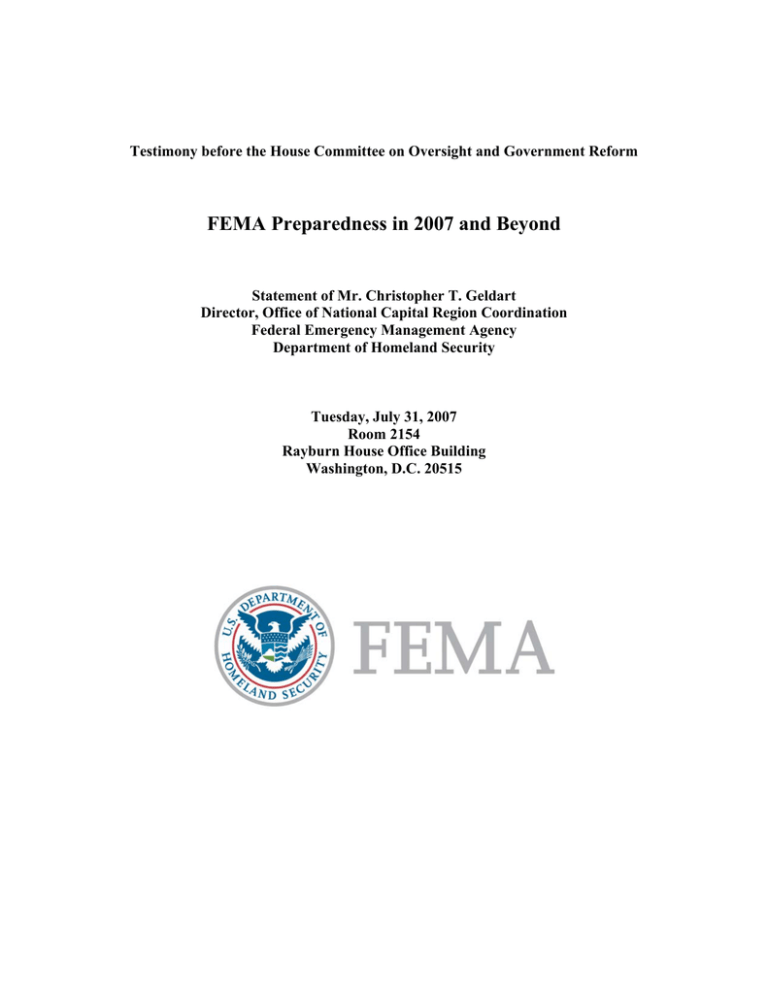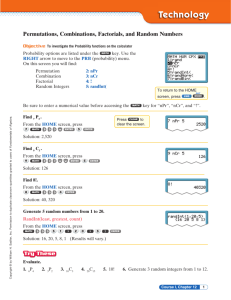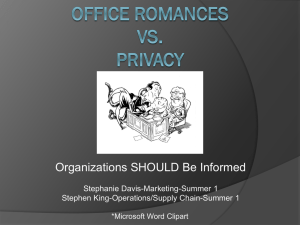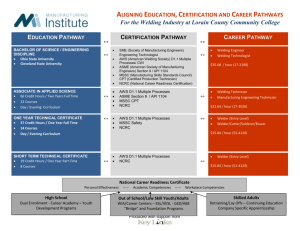FEMA Preparedness in 2007 and Beyond
advertisement

Testimony before the House Committee on Oversight and Government Reform FEMA Preparedness in 2007 and Beyond Statement of Mr. Christopher T. Geldart Director, Office of National Capital Region Coordination Federal Emergency Management Agency Department of Homeland Security Tuesday, July 31, 2007 Room 2154 Rayburn House Office Building Washington, D.C. 20515 Testimony of Christopher T. Geldart House Committee on Oversight and Government Reform Public Hearing: FEMA Preparedness in 2007 and Beyond Introduction Good morning Chairman Waxman, Ranking Member Davis and Members of the Committee. I would like to thank you for the opportunity to appear before the Committee today. I would also like to recognize my colleague Darrell Darnell, Washington, D.C.’s new Homeland Security and Emergency Management Director, and other distinguished members of the panel. I am here today to discuss the role of the Office of National Capital Region Coordination (NCRC) and how we work with our local, State, regional and Federal partners to enhance preparedness within the National Capital Region (NCR). As the new NCRC Director, I would like to outline my priorities for implementing and expanding efforts to effectively coordinate critical homeland security initiatives in a region with a geographic, economic, social and political complexity unlike any other in the Nation. The NCR is the fourth largest metropolitan area in the United States and encompasses 11 local jurisdictions across Maryland, Virginia and the District of Columbia. It is home to the second largest public transit system, more than 2,000 non-profits and international non-governmental organizations, produces a Gross Regional Product of $288b annually, is the seat of national government and home to more than 230 individual Federal departments and agencies representing all three branches of government. Most importantly, the NCR is home to more than 5 million residents and 20 million tourists annually. The complexity inherent in the region was a key factor contributing to the creation of NCRC under Section 882 of the Homeland Security Act of 2002, in which the office is charged with a broad mandate to “oversee and coordinate Federal programs for and relationships with State, local and regional authorities” within this unique region. NCRC executed its role as a staff and resource coordination element when the Office was created as a component within the Office of the Secretary in the Department of Homeland Security. However, as a result of the Post-Katrina Emergency Management Reform Act of 2006, the NCRC became a component of the newly reorganized and strengthened Federal Emergency Management Agency (FEMA) on April 1, 2007, reporting directly to the Administrator. It was just after this transition that I joined the FEMA NCRC team as its new Director. NCRC leverages key partnerships to successfully execute the strategic priorities of this Office and the region. We coordinate daily with local, State, regional, and Federal entities—to include the Joint Federal Committee, Metropolitan Washington Council of Governments, the Regional Emergency Preparedness Council, and the NCR Senior Policy Group. Stakeholders include homeland security advisors, emergency management directors, chief administrative officers, first responder leadership, and leadership from the private sector and non-profit communities for integrated regional decision-making. My Page 1 of 4 Testimony of Christopher T. Geldart House Committee on Oversight and Government Reform Public Hearing: FEMA Preparedness in 2007 and Beyond colleague Darrell Darnell is a member of the Senior Policy Group. I’m sure he can also speak to the value and accomplishments of this key partnership. NCRC Accomplishments NCRC accomplishments include working with the stakeholders mentioned above to create the region’s homeland security governance structure as well as develop the NCR Homeland Security Strategic Plan, the first of its kind in the Nation. This strategic plan serves as a roadmap for strengthening capabilities and enhancing capacity to realize the NCR partners’ vision for a safer and more secure NCR. To date, the work of NCRC has focused on capabilities development and response planning by facilitating communication among stakeholders within the NCR, and supporting the development of an operational construct to better enable effective coordination in the event of a catastrophic event. Organizing NCRC around its initial mission priorities enabled fundamental accomplishments, including the selected examples below. • The NCR was one of only four Urban Areas to achieve “Advanced” in all categories in the Tactical Interoperable Communications Scorecard assessments published by DHS in January of 2007. The Tactical Interoperable Scorecards assessed the maturity of tactical interoperable communications capabilities in 75 urban/metropolitan areas throughout the Nation. • The NCRC is a key partner in local, State, regional and Federal efforts to coordinate multi-jurisdictional training to ensure consistent operational methodologies across the region and to maximize regional resources. Since the Department’s inception, the NCRC has been a key partner in numerous table-top, command post and other exercises conducted by DHS and key NCR partners. We also continue to work with NCR stakeholders to solidify a comprehensive exercise program that will ensure continued improvement through a rigorous corrective action program, measure current capability, and provide realistic training to area responders, government officials, businesses and non-profit organizations, and the public. • NCRC coordinated the development of the NCR First Responder Partnership Initiative (FRPI), a landmark credentialing effort. The FRPI leverages Federal standards and technology to create a common identity management approach that permits First Responders to move quickly through multiple jurisdictions in the event of an incident, addressing a major challenge. Page 2 of 4 Testimony of Christopher T. Geldart House Committee on Oversight and Government Reform Public Hearing: FEMA Preparedness in 2007 and Beyond Moving Forward As the new NCRC Director, I have the opportunity to build upon the strong coordination and partnership mechanisms that have been created in the NCR to help craft enhanced homeland security policies, procedures and protocols. My goal coming in three months ago was to leverage the solid foundation provided by our existing programs along with the additional resources requested for this Office in FY 2008 to move the NCRC mission forward now that the Office is a component of FEMA. NCRC priorities for FY 2008 to FY 2013 reflect emerging regional needs and national policy guidance—specifically Catastrophic Planning, Regional Risk Assessment, and enhanced Federal agency coordination within the NCR. Catastrophic Planning Congress has clearly indicated its interest and intent regarding catastrophic planning in the NCR, particularly with respect to evacuation and mass care. The NCRC has worked diligently with NCR stakeholders and, where desired by Congress, with stakeholders beyond the immediate region to ensure coordination and inclusion in ongoing evacuation planning efforts. As the new FEMA vision moves forward, we have an opportunity to take a substantial leap in NCR catastrophic planning. By coordinating current State and local planning efforts with grant funding provided in the recent supplemental appropriation and the on-going catastrophic planning efforts underway at FEMA, we can bring resources and expertise to bear in a way that was not possible before. By coordinating these multiple efforts, we can expand our catastrophic planning efforts. Enhanced Federal Coordination The considerable presence of the Federal community—both of employees and Federal first responders—within the NCR necessitates stronger coordination than exists today. As seen in past events, communication and coordination between the Federal Government and State and local first responders must occur prior to and throughout the duration of an event—regardless of magnitude. An immediate area in which the NCR can improve its ability to respond to critical incidents is in the coordination among and between Federal agencies—a priority identified in the NCR Homeland Security Strategic Plan. NCRC’s primary focus in this area is to advance the dialogue within the Federal community in the NCR to better integrate planning and operations. The unique nature of the NCR demands a Joint Federal Coordinating Element (JFCE) to ensure coordination of protective measures and protocols in advance of an event, so that there is seamless response during an event. This is a gap in Federal response coordination that NCRC is currently working to fill. The JFCE will enable a seamless transition from steady-state operations, to incident support, and finally, to a designated Page 3 of 4 Testimony of Christopher T. Geldart House Committee on Oversight and Government Reform Public Hearing: FEMA Preparedness in 2007 and Beyond Joint Field Office—the desired end state being dynamic and continuous information sharing among joint Federal partners. Regional Risk Assessment Conducting regional risk assessment will enable informed resource allocation, and will subsequently lead to more strategic capability development. We are engaged with the DHS Risk Management & Analysis (RMA) Office to produce a way forward on a comprehensive and actionable regional risk assessment for the NCR that builds on the data collection efforts of the NCR Hazard Identification and Risk Assessment project recently concluded. The goal of this next phase will be to support more effective decision making at the strategic and operational levels, and within a regional context. Conclusion The NCRC is now at an exciting crossroad as it continues its central preparedness and coordination missions as a part of FEMA, and furthers its collaboration efforts with the local, State and regional jurisdictions that comprise the National Capital Region. Building upon the foundation that has already been constructed, the NCRC will take tangible steps to enhance catastrophic planning, improve Federal coordination, and better understand risk from a regional perspective. At the end of the day, we are all committed to one goal, the continued safety and security of this region and its residents and visitors. I would like to thank Chairman Waxman, Ranking Member Davis and the Members of the Committee for the opportunity to discuss the role of the Office of National Capital Region Coordination. I am happy to answer any questions you may have. Page 4 of 4




